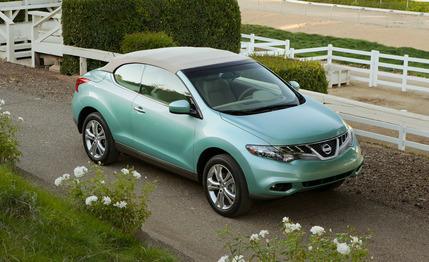
 First Drive Review
First Drive Review
Three years and a billion investment dollars after the Fisker Karma rolled forth as a stunning plug-in-hybrid concept, it’s finally ready to rock as a stunning production car. All in less time (and for far less money) than GM needed to produce the Chevy Volt.
The Karma’s recipe calls for sexy design stirred with a heap of sustainability. We had faith in the styling part of the concoction: While growing up in Denmark, Henrik Fisker inherited from his father a deep appreciation for American cars of the Sixties. Upon completing formal design studies, he put his rearing to excellent use. Warming up for the Karma, Fisker designed the BMW Z8 and the Aston Martin DB9 and V-8 Vantage—all of which stand tall next to any Corvette or Eldorado.
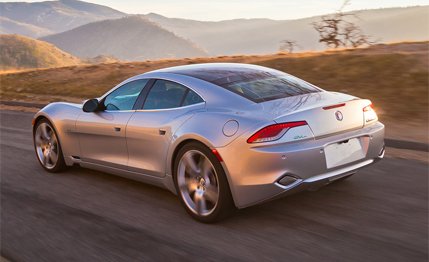

As for sustainability, in the Karma it means consuming no petroleum for the first 50 miles and interior trim that bows to Mother Nature. Indeed, the very idea of sustainability permeates Fisker’s business plan, which is backed by venture capitalists and government agencies. On the heels of the low-volume, $100,000 Karma, there will be a more affordable car, the Nina, also built around earth-friendly technology. The hope is that these two plug-in hybrids will give Fisker global reach as a viable carmaking enterprise.
The Karma lays a good foundation. Up front there’s a 260-hp, GM-supplied four-cylinder engine spinning a mighty generator. Next in line is a 20-kWh, American-made lithium-ion battery pack. Twin AC motors straddling the rear axle deliver 402 horsepower to the differential. The propulsion system, the Brembo brakes, the 22-inch cast aluminum wheels, and the aluminum suspension components are supported by an aluminum space frame stitched together with 260 feet of welds and a thousand or so rivets. The Karma’s aluminum skin is finished with a solar-cell roof, a composite decklid, and plastic bumpers.
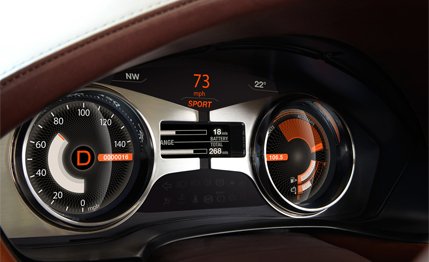

Like the Nissan Leaf, the Karma is always electrically driven; the gasoline engine powers only the generator. Slip into the elegantly tailored driver’s seat, engage “stealth” mode, and you can motor sedately to the future with little more than a hum from the powertrain. Tugging the “sport” paddle to the left of the steering wheel brings additional energy to bear. When the gasoline engine kicks in to supplement the battery pack’s wattage—to trim the 0-to-60-mph run from a claimed 7.9 seconds to 5.9, or to add 250 miles to the driving range—the extra thrust is accompanied by the whistle of a turbo spooling up, the snarl of angry exhaust gas, and a resonant boom or two. Bent on fulfilling its mission, the generator set keeps growling even when you ease off the accelerator.
The Karma’s initial surge is sufficiently potent to avoid damnation as a slug. But the physics conspire against it keeping pace with other $100K sports sedans. In spite of the joys of low-rpm electric torque, the realities of a curb weight well above 4000 pounds and only one gear ratio mean that mileage is where this car excels. Until the EPA weighs in on that subject, we can only guess that the Karma will land slightly below the Volt’s ratings of 93 equivalent mpg (MPGe) in electric driving and 35 mpg city and 40 highway with the engine running.
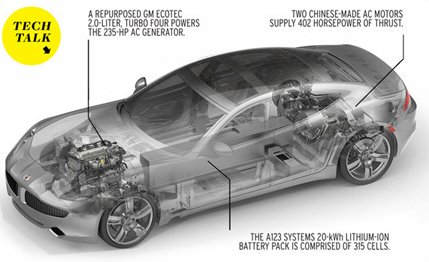

Handling is a subject we can address with more confidence. The Karma’s steering is endowed with real road feel and linear turn-in response. The ride is supple, and there’s minimal body roll when you fling the wheel; the low-mounted, 600-pound battery pack makes for an effective keel. Even though the rear wheels carry 53 percent of the Karma’s mass, there’s understeer awaiting those who visit the borderlands of grip. The brakes are calibrated to convert excess momentum into the maximum amount of charging energy without inflicting pedal weirdness.
Considering its low-slung and curvaceous flanks, the Karma provides surprisingly easy entry and cozy accommodations for four grown-ups. A 10.2-inch screen replaces the usual forest of tiny infotainment buttons with audible, visual, and tactile responses to touch commands. Trim is a cut or two above the $100,000 norm, thanks to fine detailing and lovely custom touches. The top EcoChic edition is an animal-free showcase of high-end textiles, faux suede, and rescued California wildfire hardwood.
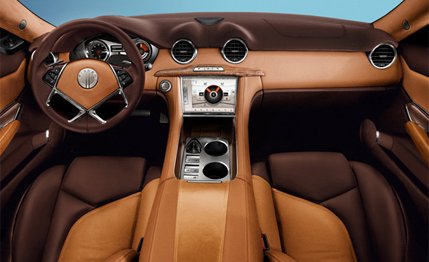

Fisker claims to have 3000 deposits in the bank. Some of those who’ve plunked down the cash are doubtless atoning for past turbo-V-8 sins, but others may be less altruistic, simply drawn to the sexiest fenders ever draped over an American sedan. Whatever their motivation, they’ll get a beautiful, luxurious machine that goes easy on the guilt.